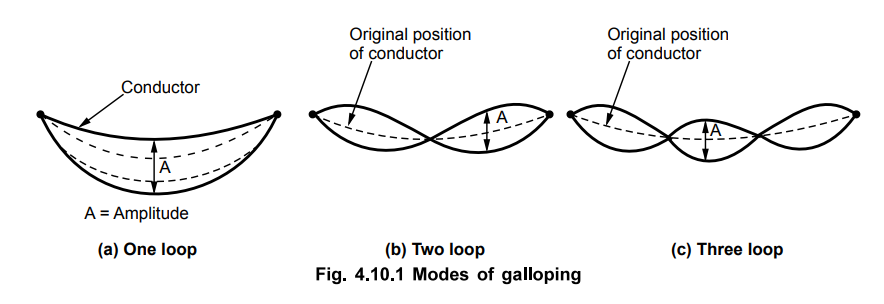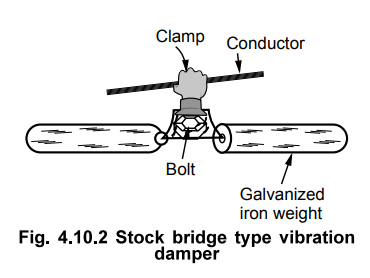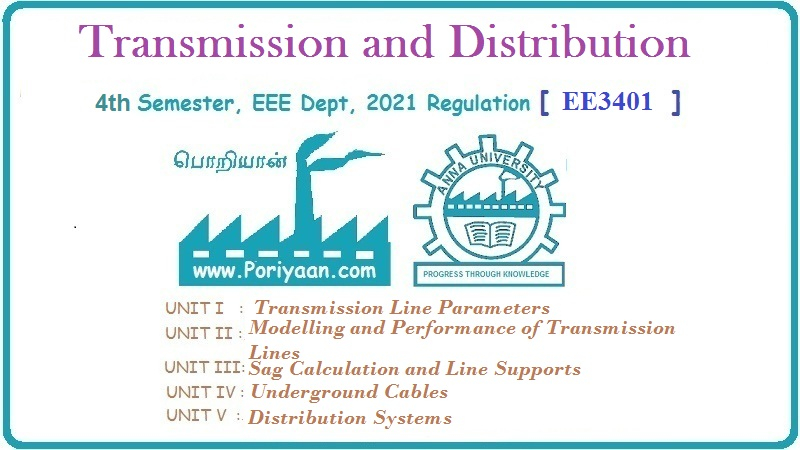Transmission and Distribution: Unit III: (a) Mechanical Design of Transmission Lines
Vibrations of Conductors and Damper
Aeoline Vibrations - Galloping of Conductors - Stock-Bridge Type Vibration Damper - Factors Affecting Conductor Vibrations
The conductors are supported on the string insulators at each tower. Under widely varying atmospheric conditions like strong wind velocities, the conductor can start vibrating mechanically in the vertical plane.
Vibrations of Conductors
and Damper
The conductors are supported on the
string insulators at each tower. Under widely varying atmospheric conditions
like strong wind velocities, the conductor can start vibrating mechanically in
the vertical plane. Such vibrations can have different frequencies, amplitudes
and modes. There are two types of vibrations in the vertical plane,
1. Aeoline vibrations and 2. Galloping
or dancing of conductors.
1. Aeoline Vibrations
The Aeoline vibrations have the
frequency range of 8 to 40 Hz with amplitudes varying between 2 to 5 cm. Thus
these vibrations are high frequency low amplitude vibrations. The wind
velocities of about 2 to 40 kmph can generate such type of vibrations.
The frequency of Aeoline vibrations is
given by,
fα = 2 (VP / d) × 103
where Vp
= Wind velocity in kmph perpendicular to conductor
d = Diameter of conductor in m
These vibrations are not much harmful.
But if the frequency of vibrations coincides with the natural frequency of the
conductors then resonant condition can be achieved. This may result in breaking
of strands and mechanical failure of the conductors.
The Aeoline vibrations are harmful from
suspension points of view. The Aeoline vibrations travel along the length of
the conductors. Now where the clamps are used and the free vibrations are
restricted, the Aeoline wave reflects back causing a momentary bending of
conductor. And this may damage the conductors. The conductors are vibrated back
and forth continuously at the suspensions due to Aeoline vibrations, such a
stress is called the metallurgical fatigue.
Use of bundled conductors, proper design
and locations of spacers and clamps and use of dampers can minimise the effects
of Aeoline vibrations.
2. Galloping of Conductors
The galloping means dancing of
conductors at the low frequency and high amplitude. These are the oscillations
of complete span of conductors. It causes the longitudinal movement of
conductors through the conductor clamps. The frequencies of galloping are about
0.25 to 1.5 Hz with the amplitudes of about 6 m. The Fig. 4.10.1 shows the
three modes of galloping.

When the wind blows past the noncircular
conductor, the galloping initiates. The oscillations are build on their own and
galloping becomes very large. The path of conductor is elliptical in galloping.
This can cause flexure fatigue and there is a possibility that conductors may
ripped off from pin insulators. If the amplitude is large more than the sag
then clashing of conductor with earth occurs and flashover may result.
The galloping is rare but possible
mainly in rainy and snowfall conditions. Apart from the icing conditions, the
galloping is rare. But when occurs it can cause damage to conductors, spacers,
clamps and towers too.
There are no methods by which galloping
can be restricted. But in icing conditions, height of the conductors can be
designed properly considering the amplitude of possible galloping. As galloping
vibrations are longitudinal, horizontal configuration of conductors can avoid
clashing of conductors during galloping.
3. Stock-Bridge Type Vibration Damper
The galloping cannot be restricted but
the Aeoline vibrations can be restricted using vibration damper. A damper used
to restrict Aeoline vibrations is called stock bridge type damper.
It consists of a steel cable. At the two
ends of the cable, two hollow specific shaped weights are fixed. At the
midpoint the damper can be fastened to the conductor by means of aluminium
clamp. The weights used are of galvanized iron. The main feature of the damper
is the grip of the damper with conductor uses only one bolt. Another feature is
that these dampers can be fastened to the conductors even though the line is
alive, using special long handled tools. The arrangement of stock bridge type
damper is shown in the Fig. 4.10.2.

The special shaped weights actually act
as dampers. The damper acts as a concentrated mass at a single point on the
conductor. The vibrational energy due to hysteresis and inter-strand friction
gets absorbed by the damper. Due to absorption of vibration wave energy, the
first vibration itself gets damped before the amplitude of vibrations becomes
significant. Thus Aeoline vibrations are reduced by the use of dampers.
Depending upon the span and the size of the conductors, the number of dampers
and their locations are selected.
4. Factors Affecting Conductor Vibrations
The various factors affecting the
vibrations of conductors are,
1. Atmospheric conditions like icing,
rain and high wind velocities.
2. Span of conductor.
3. Tension in conductor.
4. Conductor configuration.
5. Types of clamps used.
6. Height of the towers.
7. Number of dampers and spacers used
and their locations.
8. Some other factors depending on
electrical and electromagnetic phenomenon like corona.
Review Question
1. Explain the vibrations of conductors and methods to minimise
them.
Transmission and Distribution: Unit III: (a) Mechanical Design of Transmission Lines : Tag: : Aeoline Vibrations - Galloping of Conductors - Stock-Bridge Type Vibration Damper - Factors Affecting Conductor Vibrations - Vibrations of Conductors and Damper
Related Topics
Related Subjects
Transmission and Distribution
EE3401 TD 4th Semester EEE Dept | 2021 Regulation | 4th Semester EEE Dept 2021 Regulation
